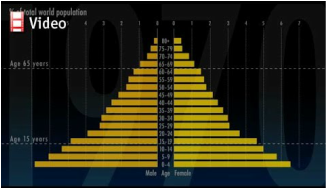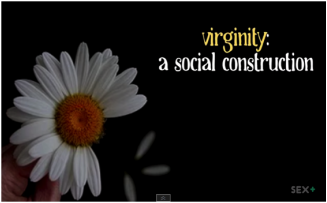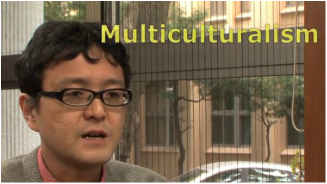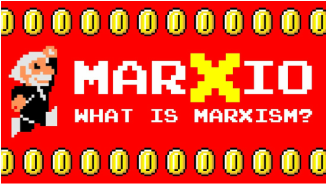 Sasheer Zamata wonders why there aren't any Black emojis. Sasheer Zamata wonders why there aren't any Black emojis.
Tags: discourse/language, inequality, media, prejudice/discrimination, race/ethnicity, science/technology, representation, subtitles/CC, 00 to 05 mins
Year: 2014 Length: 2:27 Access: Hulu Summary: Given the current media spotlight on racist patterns of violence, it's easy to lose sight of more subtle forms of racism. For instance, a daily barrage of media featuring white protagonists simply becomes an unremarked upon backdrop of everyday life, like the piped elevator music that cajoles one into humming along despite being ambivalent about the tune. One racist backdrop might be the book covers one encounters at a typical bookstore. For instance, one analyst found that in 2011 a white person was featured on roughly 90% of all young adult book covers, whereas a Person of Color could only be found on somewhere between 10% and 15% of covers. The quiet tendency to whitewash media is but one reason why representations of whiteness have come to dominate the media landscape. Black and brown characters in popular books are routinely rewritten as white characters in Hollywood film adaptations. And speaking of film and television, one 2013 study found that while whites comprised 63% of the population, they were featured on the evening cable news shows 79% of the time. • The point is not to simply draw attention to the disproportionate number of roles being written for white men and women, or the fact that whites are being given more of a voice in popular media. Instead, my aim is to simply point out that visual media, such as advertising, television, and film, play a key role in promoting the idea of whiteness as the default or universal human. More pointedly, such visual media reinforce the idea that People of Color are deviations, somehow not fully compatible with the human ideal. • Consider the phrasing, "normal to dark skin," recently spotted on a bottle of Dove body lotion. It escapes most people's attention that "normal" is being used as a synonym for "white." Whiteness is the default. In the above comedy sketch from Saturday Night Live, Sasheer Zamata points out a second example of how whiteness becomes normalized in the selection of emojis used in texting. Not one of the more than 800 emojis depicts a Black person, and as Zamata notes, "Unicode, the company that creates emojis, thought that instead of one black person we needed two different kinds of dragons, nine different cat faces, three generations of a white family. And all the hands are white, too. Even the Black power fist is white!" Submitted by: Lester Andrist
5 Comments
 The age structure of the world's population in 1970 The age structure of the world's population in 1970
Tags: aging/life course, demography/population, health/medicine, methodology/statistics, demographic transition, fertility, mortality, total fertility rate, subtitles/CC, 00 to 05 mins
Year: 2015 Length: 4:15 Access: YouTube Summary: The population pyramid is a visualization of a society's age structure and is so named because of its shape. A thick base at the bottom indicates that the largest share of the population is young, and the pyramid's steep slope, which vanishes to a point, represents the cold fact that the mortality rate increases as people age. In countries around the world, the shape of this pyramid age distribution has been observed to change, a process demographers call a demographic transition. The traditional pyramid shape is common in less industrialized societies, which is an indication that fertility and mortality rates are high and life spans are short. However, with the diffusion of medical advancements, the reach of health care services, and improvments in drinking water and sanitation mortality rates typically drop and life spans increase. And with more children surviving the first decade of life and contraception becoming more widely available, fertility rates typically plummet. The result is that the pyramid-looking age distribution begins to resemble a column. Since each successive bar represents the size of an age cohort, it follows that in a society with a stable fertility rate and a low mortality rate, the bars resist sloping inward until the older age cohorts where mortaility seems to overcome advancements in health. • As the above video from The Economist explains, demographic transitions have been observed to happen on a country-by-country basis, but if one pools data from countries around the world, it appears that the age structure of the global population is slowly undergoing one big demographic transition. In 1970, the world's population could be represented as a pyramid, but in 2015 the the pyramid more closely resembles the dome of the U.S. Capitol Building. By 2060, demographers project that the dome-like structure will give way to columns, and it may be difficult to remember why demographers ever called it a population pyramid in the first place. • It is important to keep in mind that creating these graphs is more than an exercise in data visualization, and such graphs can be useful tools for policymakers. For instance, whether the age distribution resembles a pyramid or a column has important implications for answering questions about society's tax structure and resource allocations. It is essential to know the number of people who comprise vulnerable populations, such as children and the elderly. Population pyramids and the calculations they represent can also become a catalyst for more philosophical ponderings, such as what it will mean that for the first time in human history the world will have just as many older people as children. Submitted by: Lester Andrist  "Virginity” powerfully shapes and controls people’s lives. "Virginity” powerfully shapes and controls people’s lives.
Tags: gender, sex/sexuality, social construction, heterosexism, sexism, virginity, subtitles/CC, 00 to 05 mins
Year: 2013 Length: 4:59 Access: YouTube Summary: In this video, Laci Green, a peer sex educator and YouTube blogger, tackles the issue of virginity and illustrates how past social norms contribute to contemporary ones. Green starts out by establishing the concept of "virginity" as a social construct—that is, the definition of virginity changes over time and across cultures. For instance, the definition of virginity is rather unclear. As Green explains, virginity can be hard to define with same sex partners, or in the absence of vaginal intercourse. So, what is virginity? Well, Green says it started in the Neolithic Period, back when there was no birth control and male-bodied people controlled most of the resources. There was a problem with establishing paternity if a female-bodied person had slept with more that one person. So, virginity was the answer. In order for a young female person to be eligible for marriage she must have been "pure" and virgin. There was also a financial element tied to this. In exchange for a virgin daughter, a father was paid material goods from the husband-to-be. Green highlights remnants of these early social practices in contemporary societies. For example, in honor-based societies, women who lose their virginity out of wedlock are often subjected to beatings and death for dishonoring their families with their "impurity." In other societies, fathers "give away" their white clad daughters at weddings, the white dresses being a symbol of virginity and purity. Importantly, Green acknowledges that, just because virginity is a social construct, doesn’t mean that it’s not "real." Virginity affects people’s material lives and values in many ways. The concept of virginity has a lot of power and shapes many aspects of people’s lived experiences, from controlling their sexualities to promoting heterosexism. Green suggests that we try to take away the power of the term virginity, and call the experience a "sexual debut" instead. For more of Laci Green’s peer sex ed and social justice videos, check out her YouTube channel or another post on The Sociological Cinema featuring one of her videos. Submitted By: Abigail Adelsheim-Marshall  This video examines the phenomenon of "gendered pricing." This video examines the phenomenon of "gendered pricing."
Tags: capitalism, gender, inequality, marketing/brands, prejudice/discrimination, gendered pricing, pink tax, subtitles/CC, 00 to 05 mins
Year: 2015 Length: 3:59 Access: YouTube Summary: In this video, YouTuber Liz Plank looks into how products marketed towards men and women vary in price. Liz starts out with the startling statement that women are losing $100,000 over the course of their lifetime. Not to the wage gap, but to the products they buy--the so called “pink tax.” Liz and her co-blogger Alex (a male identifying individual) take an experimental approach to this issue and head to a pharmacy to see if there really is a price difference or, pink tax, applied to women’s products. Liz and Alex each bought five personal care products that were marketed towards their genders. They made sure that their samples were consistent by checking that the products they bought were the same brand, had the same active ingredients, and were the same size. They each bought one pack of razors, a deodorant bar, shaving cream, wrinkle cream, and body wash. Liz and Alex then compared the prices of the items they bought. In total, Liz spent $42.69 and Alex spent $37.42. For the exact same products, the only difference was that Alex’s products were marketed towards men, and Liz’s towards women. Just to make sure that they actually were the same products, they swapped products for a week. After a week of using the products targeted at the other gender they found no difference in the quality or utility of their products. This led them to conclude that women are in fact getting charged a pink tax for the same products that men can buy for less. This could be because of social norms that dictate that women care more about appearance and are therefore willing to pay more for personal care items. Beauty product companies want to make as much as possible on their products, and they drive up the price of items targeted at women. Because consumers are socialized to shop in the beauty aisle marketed toward their gender and not look at the “other” gender’s products, many people do not even notice this discrepancy. Submitted By: Abigail Adelsheim-Marshall  Vox debunks the race myth in a new video Vox debunks the race myth in a new video
Tags: biology, immigration/citizenship, inequality, knowledge, prejudice/discrimination, race/ethnicity, science/technology, social construction, caucasian, mexican, racial formations, scientific racism, subtitles/CC, 00 to 05 mins
Year: 2015 Length: 3:08 Access: YouTube; Vox Summary: It often surprises students to learn that sociologists and other social scientists regard race as little more than a creation of the collective imagination, or as the above video from Vox argues, race isn't real. Contrary to popular belief, racial categories do not consistently correspond to biological observations; nor are the racial categories used today a particularly ancient means of categorizing human societies. They are, in fact, both flimsy and recent. • The social theorist David Theo Goldberg argues that starting in the sixteenth century racial thinking and racist articulation became increasingly common in European societites. As Vox explains in the above video, one crucial moment of racist articulation appears to have occurred nearly two centuries later when in 1779 German scientist Johan Friedrich Blumenbach is credited with attempting to establish a scientific, race-based system of classification. Although his work has long been discredited, it is worth noting that he arrived at five hierarchically organized racial categories: "Caucasian, the white race; Mongolian, the yellow race; Malayan, the brown race, Ethiopian, the black race, and American, the red race." Not surprisingly, he ranked Caucasians highest on his racial hierarchy. • For those who remain unimpressed by the fact that racial thinking is a relatively recent phenomenon in human history, consider the fact that racial categories and their hierarchical arrangement have been shown to change with political priorities. In academic parlance, racial formations have continued to be created, transformed, and destroyed. For instance, the video explains that the U.S. Census categorized people with Mexican ancestry as white until 1930, at which point the Census began categorizing these whites as an emergent racial category known simply as "Mexican." The change in Census categories reflected a developing racial discourse in the American Southwest but it also played a role in temporarily limiting immigration from Mexico, and fewer immigrants from Mexico meant higher wages for whites. • Properly contextualized, the reason for the emergence of racial thinking in Western Europe seems fairly clear. Although it is assumed race is based on natural, biological differences, the truth is that racial thinking has had very little to do with accurately describing natural variation in human populations and far more to do with whites maintaining power, privilege, and resources at the expense of nonwhites. Although race isn't real in a biological sense, as the video explains, it has become hugely important in a social sense. The racial categories to which we're assigned can determine real life experiences. Submitted By: Lester Andrist  Dr. Shiobara uses a comparative methodology to examine how policies of multiculturalism shape different cultures. Dr. Shiobara uses a comparative methodology to examine how policies of multiculturalism shape different cultures.
Tags: culture, demography/population, globalization, immigration/citizenship, methodology/statistics, multiculturalism, race/ethnicity, australia, japan, migration, multiculturalism, subtitles/CC, 00 to 05 mins
Year: 2014 Length: 4:17 Access: YouTube Summary: In this video, Professor Yoshikazu Shiobara of the Keio University Department of Political Science (Faculty of Law) discusses his research on multiculturalism in Japan and Australia. As noted by Dr. Shiobara, "I study various changes in societies associated with globalization, changes in industrial structures, multi-ethnic and multicultural developments in nation-states, migration of people, and growth in immigration. In particular, I specialize in the concept and policies of multiculturalism, and I investigate how they affect people in the host society which accepts ethnic minorities, in the form of immigrants, social minorities, and indigenous peoples. I research these issues in terms of both theory and evidence." His work compares multiculturalism in Australia, which was one of the first to implement a policy of multiculturalism, and Japan, which has yet to systematize policies at the national level. This approach identifies social policies of migrants in these two countries, and their impacts on dominant cultures, migrating cultures, and indigenous populations. This is a useful example of comparative research methods, cross-cultural studies, migration, and global sociology. A full transcript of the short clip is available in the video's description on YouTube. Submitted By: Bhoomi K. Thakore  Chescaleigh offers a helpful tutorial for how to apologize. Chescaleigh offers a helpful tutorial for how to apologize.
Tags: discourse/language, social mvmts/social change/resistance, ally, oppression, subtitles/CC, 06 to 10 mins
Year: 2013 Length: 8:36 Access: YouTube Summary: In this video, Franchesca “Chescaleigh” Ramsey talks about getting called out and how to apologize. Chescaleigh defines “getting called out” as not simply having our feelings hurt or feeling slighted. Rather, she argues, “getting called out is when you say or do something that upholds the oppression of a marginalized group of people.” Chescaleigh offers suggestions for what to do in instances when we’ve committed this type of oppressive act and it’s been brought to our attention. She begins with a couple of basic principles. First, rather than get defensive when called out, we need to listen. This is an important moment, as it hopefully creates the opportunity for the other person to explain what we did wrong and how we can change it. Second, don’t try to explain away our “true” intent (e.g., “Oh, I didn’t mean it that way”). It’s very likely the case that we didn’t mean to offend, but our intent is not what matters; rather, it’s the impact of the behavior that counts. Using these guiding principles, Chescaleigh illustrates the difference between “good” and “bad” apologies, and explains why common apologetic statements such as “I’m sorry you were offended” and “I’m sorry if you were offended” fall woefully short. Instead, if we want to give a genuine “good” apology, we must (1) take responsibility for what we did and (2) make a commitment to change the behavior. To illustrate her point, Chescaleigh uses an example from her own experience of getting called out and needing to apologize. She concludes the video by summarizing how to apologize in the following four steps: (1) acknowledge what went wrong, (2) don’t put “conditions” on your apology by using words like “but” and “if”, (3) consider thanking the person who called you out; calling others out isn’t easy to do, and (4) change your behavior. The act of apologizing after getting called out is part of what it means to be a good ally (see here). Submitted By: Valerie Chepp  Eri Hayward discusses her life as a trans woman Eri Hayward discusses her life as a trans woman Tags: inequality, intersectionality, lgbtq, prejudice/discrimination, religion, cisgender, mormon, trans*, transgender, subtitles/CC, 11 to 20 mins Year: 2014 Length: 14:52 Access: YouTube; Vimeo Summary: This short documentary entitled Transmormon, tracks the life of Eri Hayward, who was born and raised in Utah as a Mormon. Eri discusses how she had to come to terms with the fact that the gender she was assigned at birth was not the gender she knows herself to be. As she prepares for sex reassignment surgery, she and her parents recount her journey and how she has worked to reconcile her transgender identity with her religious beliefs as a member of the Church of Jesus Christ of Latter-day Saints. People are often hesitant to talk about what has been clearly stigmatized, so Transmormon provides an an excellent means of beginning a discussion about transgender experiences and identities. The film centers on Eri's intensely personal experiences growing up, but students can be encouraged to think about the implications of widespread stigmatization against transgender people, including the role it plays in creating high levels of violence and discrimination, higher rates of suicide, and inferior access to health care. To learn more about the public issues many transgender people face, explore our Pinterest board on the topic. Submitted By: Samuel H. Allen  Wilmore and guests discuss Black fatherhood on The Nightly Show Wilmore and guests discuss Black fatherhood on The Nightly Show Tags: community, demography/population, marriage/family, media, methodology/statistics, prejudice/discrimination, race/ethnicity, fatherhood, larry wilmore, parenting, racism, stereotypes, subtitles/CC, 21 to 60 mins Year: 2014 Length: 21:29 Access: The Nightly Show Summary: When people hear the majority of Black babies are born “out-of-wedlock,” most either feel dismay or distrust at the statistic. However, Larry Wilmore and his panel of artists, authors, and activists confront the accuracy of this statistic and Black fatherhood more generally in a roundtable discussion. In Part 1, New York Times columnist Charles M. Blow explains how context matters, and the rate of births to unmarried Black women reflects the decline in fertility for married Black women, the mass incarceration of Black men, the diminishing importance placed on the traditional nuclear family, and the embracement of more flexible parental roles in our cultural more generally. Part 2 begins with a discussion about how media figures and politicians utilize deeply embedded racial (or racist) stereotypes to explain this statistic (and many others) in prejudicial ways. Part 2 then closes with the panelists offering their own experiences with their fathers and being dads themselves, thus revealing how in the interpreting of statistics many people (perhaps sociologists even more so than others) reify and over-generalize numbers, forgetting every “case” in a sample is actually a unique person, with their own unique experiences that is not readily apparent in macro data. Submitted By: Jason T. Eastman  A vintage video game is used to discuss Marxism. A vintage video game is used to discuss Marxism. Tags: capitalism, class, economic sociology, marx/marxism, political economy, theory, alienation, dialectical materialism, philosophy, subtitles/CC, 00 to 05 mins Year: 2014 Length: 3:51 Access: YouTube Summary: This video is part of a series of 8-bit Philosophy, which seeks to “communicate even the most complex of philosophical concepts in a fun, easy-to-understand way.” It uses vintage video games (from the original Nintendo) to explain complex philosophical ideas. Using quotes from The German Ideology and other works, with altered scenes from Super Mario Brothers, the narrator explains several concepts within Marxist theory. For example, the narrator explains that Marx argued it was not ideas that drive historical change, but "it is our conflict arising out of our relation to material goods" that shapes history. This process of historical materialism is explained in terms of the economic systems and social relations of a society; it is simultaneously illustrated using a character from the video game (Toad) and its weapons (a turnip) that reflect commodities that the character produces. Other concepts include exploitation, the four forms of alienation, and communism—all placed in the context of familiar Super Mario Bros references, such as Bowser, collecting coins, and the classic background music. Submitted By: Paul Dean |
Tags
All
.
Got any videos?
Are you finding useful videos for your classes? Do you have good videos you use in your own classes? Please consider submitting your videos here and helping us build our database!
|
 RSS Feed
RSS Feed
